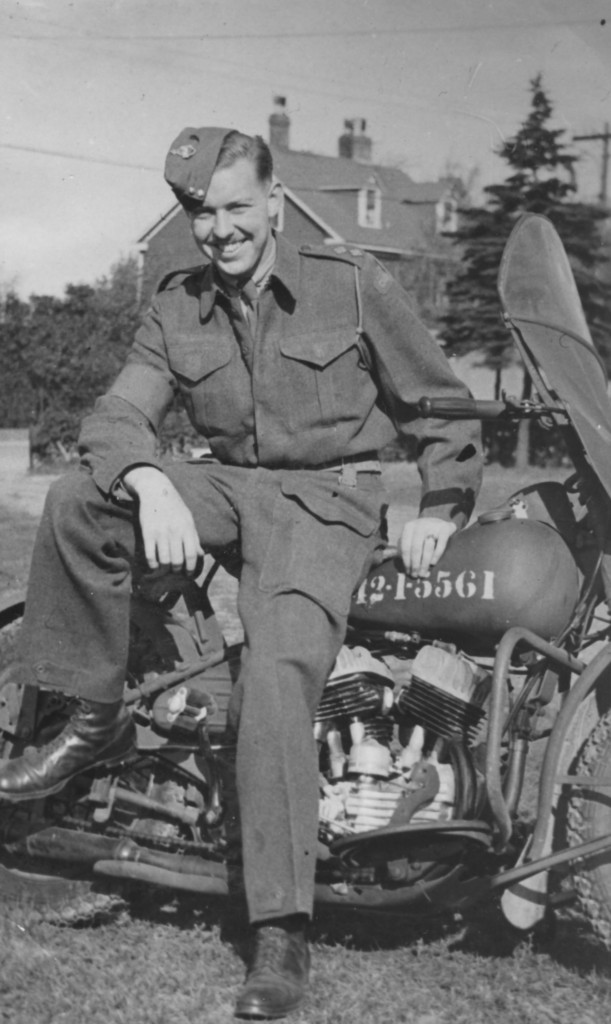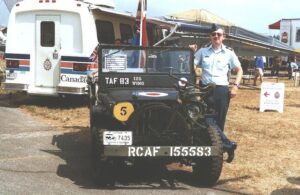Military vehicle manufacturers used many types of serial number systems, everything from simple to complex. In addition to being different lengths and combinations of letters and numbers, there was the real possibility of duplication of numbers between manufacturers. Also, the longer the number, as in modern Vehicle Identification numbers, means that there are more chances of errors by soldiers. Military forces liked to either put their registration number on the vehicle or on a licence plate.
It is NOT a “hood number” as most collectors mistakenly call it. It is a registration number which had various names depending upon the country. It is not a “hood number” as it is not always seen on a hood, which the British called a bonnet. The registration number may also be seen on the sides of the vehicle on doors, under door wells or over rear wheel wells on the rear panels or canvas, in the centre of the windshield and on the front bumper or on a plate attached to it. It may also be seen in whole or in part on some military licence plates.
U.S. Army in World War II
The first two numbers identified the group the vehicles was in. e.g. a number starting “20” such as 20457635 was a car or light truck such as a jeep. On American vehicles this usually has “USA” above the number. An “S” is often seen in front of the number but was not part of it. The “S” referred to Suppressed for radio. In other words, the body parts were all connected with bonding straps so that the body did not cause interference with the radio.
British Army in World War II
The British had one series of numbers for armoured vehicles e.g. T123456 and a second series of War Department Census Numbers for “B” vehicle, i.e. soft-skin vehicles e.g. Z5453378. Eventually those lists had over six million numbers assigned. In general, the British issued block of numbers for each contract purchase. Exceptions included blocks of numbers for impressed vehicles (civilian vehicles taken for was service), for those assigned in the Middle East and North Africa, and for Canadian vehicles.
Initially Canadian Army vehicles were assigned small blocks of numbers. e.g. in the 116xxxx range. As Canada became a huge producer of military vehicles and as her army grew. the British stopped allocating smaller batches of Census Numbers to Canada and chose to issue a huge block of numbers 4,200,000 to 4,299,999. e.g. CM4242313. This has confused many vehicle restorers and museum who assumed that the first two digits were the year. By coincidence many of the vehicles were indeed made in 1942 but the number was 4 million, two-hundred thousand and something. Another common mistake is the number of digits. For armour it was 6 numbers. For soft skins it was 7 numbers.
The British system used a code letter to indicate the class of vehicle since all of the numbers were in the same series. When vehicles were taken into Canadian service, a “C” prefix was added. If a Canadian vehicle went into British service, the “C” prefix was either never applied or if present, was painted over.
British Prefix Letters
-
- A = Ambulances
- C = Motorcycles (the “C” in cycle)
- D = Tractors, tracked (came from the early Dragoon category of vehicles pre-war)
- E = Engineer Special Purpose Vehicles
- F = Armoured Cars / Scout Cars
- H = Tractors, wheeled (e.g. Field Artillery Tractors)
- K = Probably “Experimental” as it was used for experimental tracked jeeps
- L = Lorries (i.e. trucks over 15 Cwt. 1 Hundredweight = 112 pounds. 15 Hundredweight = U.S. 3/4 ton load carrying cross-country capacity of the U.S. Army)
- M = Cars light (included jeeps and staff cars)
- P = Amphibious (e.g. Ford GPA jeeps and DUKW trucks)
- S = Self-propelled (e.g. Sexton self-propelled cannon)
- T = Universal Carrier and Tanks (6 digit number after the letter(s) as they were on a separate list)
- V = Vans (a British designation for a truck with no bows, so it resembles a pick-up truck of today. Obsolescent by 1944. Totally different from a North American concept of a van having an enclosed sheet metal body as in a delivery van.)
- X = Trailers
- Z = Trucks (up to 15 Cwt. capacity).
- As I recall, there were a few British tanks that had their own prefix letter designation, based upon their name.
Canada in World War II
PRE-WAR TO 1942 DND NUMBER SYSTEM e.g. 41-1-1234 or 41-1234
Prior to World War II, Canada used a system of vehicle registration numbers called Department of National Defence Department Numbers (DND Numbers) that listed the last two digits of the year the vehicle entered service. This was usually the year it was built, but it could be the year after it was built if it was taken in strength early in the year e.g. a vehicle built in December 1941 might have been taken on strength in January or February 1942.
A centre number “1” if it was NOT held by the Royal Canadian Army Service Corps (RCASC), and a number up to 4 digits long to indicate the sequence it was added that year. Thus 41-1-1234 came into service in 1941, was NOT Royal Canadian Army Service Corps (R.C.A.S.C.) issue and was the 1,234th vehicle taken onto that system that year.
The second example. 41-1234 would be a vehicle taken on strength in 1941, by the R.C.A.S.C. and the 1,234th vehicle taken on strength that year. As one can see, having two overlapping number systems could be confusing and lead to errors with all of the near duplicate numbering.
1943 DND NUMBER SYSTEM e.g. 61.261
At the beginning of 1943, a new numbering system was introduced. All existing vehicles in Canada were renumbered. ll vehicles on the old system were renumbered. Oddly they were done so randomly at the holding unit level. This is confirmed by documents in the |Seaforth Highlanders of Canada Museum & Archives which I started in 1972.
-
- 2,000 block was allocated for motorcycles.
- 20,000 and 30,000 blocks were allocated to the Royal Canadian Air Force (RCAF)
- 50,000 and up was allocated to the Canadian Army in Canada.
- It is not known what the Royal Canadian Navy used.
As the stencil cutters and sets often did not include a dash (-), a period was often used in its place. A clever sign painter could use the centre bar of an “E” to create the dash. Thus, on one 1942 Willys jeep that I used to own, serial number MB155796, the DND number was 61.261
When Canadian vehicles were sent to the Far East, they were usually assigned numbers from the Indian Army series e.g. /|\ 23456 (A fictitious number.) The last three digits were larger that the first two.)
Overseas in Newfoundland
When Canadian Army vehicles were sent to Newfoundland, they retained their Canadian DND number. Newfoundland did not join Canada until 1949, after WWII, so it was considered to be an overseas posting.


Canadian Army (Overseas)
e.g. CM4242313 (one of General Crerar’s jeeps) The Canadian Army used War Department Census numbers allocated by the British. Initially these were in small batches, but then the British allocated 4,200,000 to 4,299,999 to Canada and Canada then controlled allocation. Note that the “42” has nothing to do with the year. The first letter was for Canada. The second letter was for a vehicle Classification.
Royal Canadian Air Force (RCAF)

When RCAF vehicles were sent overseas to the UK and Europe, they usually received a Royal Air Force number e.g. RAF 12345 or RCAF 155583 although at least one C8A was photographed in the UK still bearing its DND number. In the Far East, the Indian numbering system was used.
-
-
Military Vehicles
-
Military Vehicle Markings (this page)
-
My Military Vehicles
-
BSA Airborne Bicycle
-
Welbike
-
Canadian Military Pattern Vehicles (CMP)
-
Modified Conventional Pattern Vehicles (MCP)
-
Standard Military Pattern Vehicles (SMP)
-
Jeeps & Canada
-
Trailers
-
Return to Military Vehicles page
-
RETURN TO HOME PAGE
-